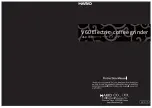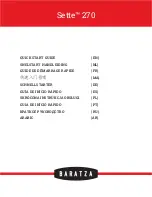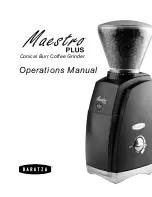
pinching. Abrasive wheels may also break under these
conditions.
Kickback is the result of power tool misuse and/or in-
correct operating procedures or conditions and can be
avoided by taking proper precautions as given below.
a)
Maintain a firm grip on the power tool and po-
sition your body and arm to allow you to resist
kickback forces. Always use auxiliary handle, if
provided, for maximum control over kickback or
torque reaction during start-up.
The operator can
control torque reactions or kickback forces, if proper
precautions are taken.
b)
Never place your hand near the rotating access-
ory.
Accessory may kickback over your hand.
c)
Do not position your body in the area where power
tool will move if kickback occurs.
Kickback will
propel the tool in direction opposite to the wheel’s
movement at the point of snagging.
d)
Use special care when working corners, sharp
edges etc. Avoid bouncing and snagging the ac-
cessory.
Corners, sharp edges or bouncing have a
tendency to snag the rotating accessory and cause
loss of control or kickback.
e)
Do not attach a saw chain woodcarving blade or
toothed saw blade.
Such blades create frequent
kickback and loss of control.
5.4 Safety warnings specific for grinding and
abrasive cutting-off operations
a)
Use only wheel types that are recommended for
your power tool and the specific guard designed
for the selected wheel.
Wheels for which the power
tool was not designed cannot be adequately guarded
and are unsafe.
b)
The guard must be securely attached to the power
tool and positioned for maximum safety, so the
least amount of wheel is exposed towards the op-
erator.
The guard helps to protect operator from
broken wheel fragments, accidental contact with
wheel and sparks that could ignite clothing.
c)
Wheels must be used only for recommended ap-
plications. For example: do not grind with the side
of cut-off wheel.
Abrasive cut-off wheels are inten-
ded for peripheral grinding, side forces applied to
these wheels may cause them to shatter.
d)
Always use undamaged wheel flanges that are of
correct size and shape for your selected wheel.
Proper wheel flanges support the wheel thus redu-
cing the possibility of wheel breakage. Flanges for
cut-off wheels may be different from grinding wheel
flanges.
e)
Do not use worn down wheels from larger power
tools.
Wheel intended for larger power tool is not
suitable for the higher speed of a smaller tool and
may burst.
5.5 Additional safety warnings specific for abrasive
cutting-off operations
a)
Do not ²jam² the cut-off wheel or apply excessive
pressure. Do not attempt to make an excessive
depth of cut.
Overstressing the wheel increases the
loading and susceptibility to twisting or binding of
the wheel in the cut and the possibility of kickback or
wheel breakage.
b)
Do not position your body in line with and behind
the rotating wheel.
When the wheel, at the point
of operation, is moving away from your body, the
possible kickback may propel the spinning wheel
and the power tool directly at you.
c)
When wheel is binding or when interrupting a cut
for any reason, switch off the power tool and hold
the power tool motionless until the wheel comes
to a complete stop. Never attempt to remove the
cut-off wheel from the cut while the wheel is in
motion otherwise kickback may occur.
Investigate
and take corrective action to eliminate the cause of
wheel binding.
d)
Do not restart the cutting operation in the work-
piece. Let the wheel reach full speed and carefully
reenter the cut.
The wheel may bind, walk up or kick-
back if the power tool is restarted in the workpiece.
e)
Support panels or any oversized workpiece to
minimize the risk of wheel pinching and kickback.
Large workpieces tend to sag under their own weight.
Supports must be placed under the workpiece near
the line of cut and near the edge of the workpiece on
both sides of the wheel.
f)
Use extra caution when making a "pocket cut"
into existing walls or other blind areas.
The pro-
truding wheel may cut gas or water pipes, electrical
wiring or objects that can cause kickback.
5.6 Safety warnings specific for wire brushing
operations
a)
Be aware that wire bristles are thrown by the
brush even during ordinary operation. Do not
overstress the wires by applying excessive load
to the brush.
The wire bristles can easily penetrate
light clothing and/or skin.
b)
If the use of a guard is recommended for wire
brushing, do not allow any interference of the
wire wheel or brush with the guard.
Wire wheel or
brush may expand in diameter due to work load and
centrifugal forces.
5.7 Additional safety instructions
5.7.1 Personal safety
a)
Always hold the power tool securely with both
hands on the grips provided. Keep the grips dry,
clean and free from oil and grease.
b)
Breathing protection must be worn if the power
tool is used without a dust removal system for
work that creates dust.
c)
Improve the blood circulation in your fingers by
relaxing your hands and exercising your fingers
during breaks between working.
d)
Avoid touching rotating parts. Switch the power
tool on only after bringing it into position at the
workpiece.
Touching rotating parts, especially rotat-
ing insert tools, may lead to injury.
en
23
DCG 230-D / DAG 230-D, Art. Nr.71747/A2, 05.03.2013
Printed: 08.07.2013 | Doc-Nr: PUB / 5069494 / 000 / 01
















































